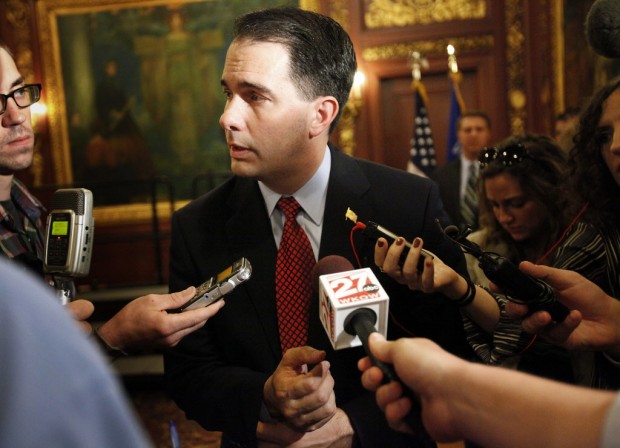One week ago, a group of concerned faculty, staff, and students organized a forum at UW-Madison to discuss shared governance: what it is, how it's been challenged in the past, and what current risks it's currently facing. The forum, held at 5 pm on the Monday before Thanksgiving, drew more than fifty people to the Wisconsin Idea Room in the School of Education. Speakers included former chair of the University Committee,
Judith Burstyn, Professor Emeritus of History
Jim Donnolly, Professor of Political Science
Don Downs,
David Ahrens of the Wisconsin University Union, and C
had Goldberg, Professor of Sociology.
There was a robust conversation about the precedent set by the famed
Spoto case in establishing the importance of
joint decision-making in shared governance, a process that in the University of Wisconsin System goes well beyond simply advice and input. The key takeaway: when faced with an
impasse between faculty and administration on an issue over which faculty have primary domain (e.g. academic affairs), both parties must continue to negotiate until an agreement is reached. Until then, no action can be taken by either side.
My sense is that leaders all over campus-- administrators, faculty, staff, and students-- misunderstand this key attribute of shared governance. The buck simply stops without agreement. There is no right to "move on" without compromise. Simply collecting input, providing information, holding listening sessions, etc, that's all wonderful but also entirely insufficient without explicit agreement.
It's nearly impossible to overstate the importance shared governance to the University of Wisconsin System, to maintaining high academic standards, crafting an engaged body of teaching and learning, and ensuring operations that are high quality and cost-effective. We have no faculty union -- no collective voice-- while shared governance is a collection therefore of individuals, it is what we have.
I will end with a wonderful talk given by Chad Goldberg during the forum. He's quite the wordsmith, so I'm grateful to him for allowing me to post it in full.
**************
"Current Challenges to Shared Governance at UW-Madison"
Chad Alan Goldberg
November 19, 2012
"I’ve been asked to speak about current challenges to shared governance. I will talk about two kinds: external challenges, from outside authorities, and an internal challenge, from faculty disengagement. Ultimately, I will suggest, the latter encourages and reinforces the former.
The external challenges, though predating the current HR Redesign Project, have been thrown into stark relief by the Administration’s handling of it.
To be sure, the HRDP has been participatory in a certain sense. The Administration formulated the “Strategic Plan for a New UW-Madison HR System” based on the recommendations of eleven work teams on which many employees served, and it followed up the release of the plan with information sessions at which further feedback was elicited. Notwithstanding the problems that David Ahrens and others have noted, including disproportionate representation of OHR on the teams work teams and dependence on their technical expertise, this attempt to gather input from employees was commendable. I availed myself of some these opportunities, as did many others. However, providing feedback and input is no substitute for shared governance, especially when people must rely on an atomistic and aggregative mode of producing public opinion that demobilizes them.
Furthermore, the language in the “Strategic Plan for a New UW-Madison HR System” was itself problematic. Shared governance was redescribed there as giving “input” and “feedback.” We did not want to see this definition of shared governance fixed in place by the plan and, worse yet, endorsed by the Faculty Senate itself.
We moved to postpone endorsement of the “Strategic Plan” at the November 5th Faculty Senate meeting for two reasons. First, we were asked to vote on a plan before it was finalized. As my colleague Sara Goldrick-Rab put it, this would be like signing off on a master’s thesis before it was finished. Second, we were asked to endorse a plan despite ongoing controversy about and significant resistance to specific changes affecting the job security and wages and compensation of other university employees. Vice Chancellor Darrell Bazzell’s comments to some of the Faculty Senators calling for postponement were revealing. The Vice Chancellor asked why we were doing this, and he expressed concern that postponement would deprive the faculty of a chance to vote on the plan before it was sent to the Regents. Not only did these remarks reduce shared governance to a plebiscite, they also implied that the plan’s executive sponsors can act unilaterally, without agreement from the faculty.
I see these external challenges to shared governance as part of a broader erosion of the rights of faculty, staff, and students to participate in decision-making on campus. Another instance of this erosion is the evisceration of collective bargaining rights by Act 10. While the Administration cannot be held responsible for Act 10, it can be criticized for its unwillingness to commit itself to a “meet-and-confer” process in the absence of collective bargaining. In addition, current disputes over WISPIRG funding indicate that students are also facing an erosion of their rights. As I understand it, WISPIRG funding requires, in addition to student approval, a contract with the University, which has been signed by previous chancellors in the past. Interim Chancellor David Ward has yet to grant the contract that the Associated Students of Madison requested almost a year ago to keep WISPIRG in existence. His refusal appears to stem from a legal dispute about the process by which student government should identify student needs and act to meet them. Should the Administration prescribe this process on the basis of its interpretation of the relevant statutes? Surely students ought to have the right to determine how best to identify their needs and to decide where their fees go. What do students learn about democratic citizenship when those rights are denied?
Alongside these external challenges to shared governance, the HR Design Project has also underscored an important internal challenge. Insufficient faculty engagement in the HRDP is symptomatic of what, many years ago, Alexis de Tocqueville called individualism: the tendency that “disposes each member of the community to sever himself from the mass of his fellows and to draw apart with his family and his friends, so that after he has thus formed a little circle of his own, he willingly leaves society at large to itself.”
Insufficient faculty engagement in the HRDP is a kind of abdication of responsibility for the university’s public affairs—not an abdication by all faculty, and certainly not by the University Committee, but by a significant portion of the faculty and even, I suspect, by some members of the Faculty Senate itself.
There are many reasons for this abdication. Faculty are extremely busy people, which leads to a desire to delegate: let Pushkin do it, where Pushkin in this case is the Administration or OHR or perhaps the UC. The perception that the HRDP affected faculty less than other university employees also no doubt discouraged faculty engagement. And we generally trust the groups to which we seek to delegate such matters. Trust is not a bad thing. As a sociologist, I know institutions and organizations cannot operate without it. Still, it’s worth bearing in mind the old Russian folk saying: trust but verify.
I’m not suggesting that faculty have the time or expertise to design the university’s personnel system ourselves, but we need to be engaged in the process, and not just as individuals but collectively, as a body, through the Faculty Senate.
Why is individualism a problem? Because the alternative, as Tocqueville pointed out, is guardianship and tutelage. Bad guardians use their power to make decisions with which citizens may not agree and which may even be detrimental to their interests. But even in the best case, when benevolent guardians have our best interests at heart, guardianship gradually degrades our capacities to think, feel, and act for ourselves in matters that affect us and for which we have a legal responsibility."
















